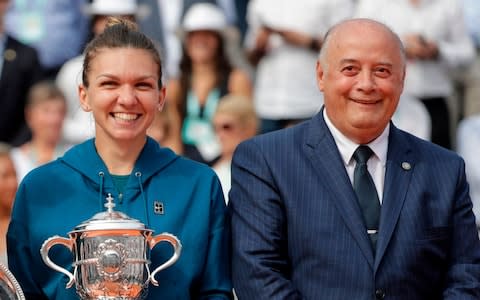Serena Williams plays down French Open threat to ban catsuit: 'It wouldn’t be a big deal'

Citing strong relations with the organisers of the French Open, Serena Williams took a conciliatory line on Saturday on their threat to ban her iconic black catsuit from Roland Garros next year.
In a magazine interview that came out last week, the French Tennis Federation president, Bernard Giudicelli, had said that he wanted to exercise more control over what players wore during the showpiece event.
“Serena’s outfit this year, for example, would no longer be accepted,” he explained. “You have to respect the game and the place.”
This sounded like a provocative gesture and brought plenty of adverse comment from writers and pundits. “This is so dumb and stupid it hurts,” said Williams’s close friend Andy Roddick. Many critics questioned why the FFT was interfering and cited the precedent of Anne White, another American who caused a sensation when she wore a white catsuit at Wimbledon in 1985.
But when Williams took questions for the first time here on Saturday on the issue, she played down any ill-feeling. Instead, she laughed and told reporters: “Everything is fine, guys.”

Expanding on her relationship with Giudicelli, she said: “The president of the French Federation, he’s been really amazing. He’s been so easy to talk to. My whole team is basically French, so we have a wonderful relationship. I’m sure we would come to an understanding and everything will be OK. Yeah, so it wouldn’t be a big deal. He’s a really great guy.”
Fashion has been a major element of tennis since the dawn of the sport 130-odd years ago, and the right of women to wear what they want has been debated for just as long.
Suzanne Lenglen’s Flapper-style outfits became her trademark when she achieved global fame in the 1920s, while Gussie Moran’s lace-trimmed knickers provoked a storm in 1949. Williams’s catsuit was thus maintaining the great traditions of the sport when it caught the headlines at the end of May.
Her first-round win over Kristyna Pliskova in Paris was uneventful in a tennis sense – except that it represented her first grand-slam match since the previous year’s Australian Open.
But the photographs made front pages around the world and Williams turned her fashion statement into a rallying cry when she tweeted: “Catsuit anyone? For all the moms out there who had a tough recovery from pregnancy – here you go. If I can do it, so can you.”
You can take the superhero out of her costume, but you can never take away her superpowers. #justdoitpic.twitter.com/dDB6D9nzaD
— Nike (@Nike) August 25, 2018
The unusual garment did also have a practical benefit. Williams has a tendency to suffer from blood clots and thus insists on wearing compression clothing when she competes.
“I’ve since found other methods,” she said. “I wear tights that keep everything going with my blood, make sure that I’m staying pretty healthy out there. When it comes to fashion, you don’t want to be a repeat offender. It will be a while before this even has to come up again.”
Williams is not known as a person who backs down easily, but in this case one suspects that her French coach – Patrick Mouratoglou – might have played a role. Mouratoglou recently opened a large tennis complex near Nice, where many of France’s leading players train. For him, maintaining a strong working relationship with Giudicelli can only be beneficial.
The bookmakers are still quoting Williams as the favourite for the US Open title, despite her world ranking of No 26 and a tally of only 12 wins – half of which came at Wimbledon – from six events this season. A month ago, she suffered the heaviest defeat of her professional career – a 6-1, 6-0 loss at the hands of British No 1 Johanna Konta – which she later attributed to her emotional upheaval at seeing the man who shot her sister, Yetunde, being released from prison.
Those shocks befell Williams during a brief appearance in California, at the Silicon Valley Classic in San Jose, and she then crashed out of her following tournament – in Cincinnati a fortnight later – at the hands of Petra Kvitova as early as the second round.

Still, as Chris Evert, the ESPN pundit, pointed out last week: “I didn’t really feel like that was a failure for her [Williams]. I felt like for a set, set and a half, she definitely had her ‘A’ game going [against Kvitova]. I hear her say that she can feel it and taste it and she’s close and she needs to keep working harder – and you know she is.”
Asked about the oddsmakers on Saturday, Williams raised her eyebrows. “That I would be the favourite at this point, almost a year after having a baby, is quite interesting,” she replied. “I don’t know my draw [which could feature sister Venus in the third round, followed by world No 1 Simona Halep in the fourth], but if I want to be the best, I’m going to have to start beating these people anyway.
“That’s the message I’ve been preaching to women and people; that we face obstacles. Whether you get through them or not, there’s always another chance. Things don’t always go your way, but continue to climb that mountain.”

